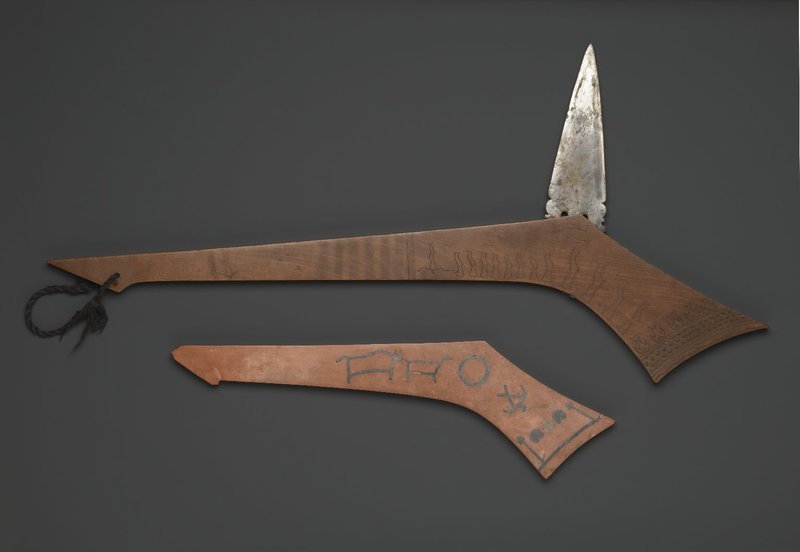War Club Item Number: 50.67.67 from the Brooklyn Museum

Description
A war club with an attached metal blade. A twisted cotton cord is attached to the handle. The object's decoration is done by chip carving and incising. Fourteen headless figures are shown on one side of the club and an Indian head is etched onto the metal blade. Possible explanation: The designs cut into the end of the club in rows of triangular shapes represent tipis. Probably, the scene depicted is a recounting of the exploits of the owner of the club. The figure on the end holds a feathered lance or staff, possibly a medicine man. The others, all male that are facing another single male, are men that he touched (coup counting) or killed.
Credit Line
Henry L. Batterman Fund and the Frank Sherman Benson Fund
Label
THE JARVIS COLLECTION
The articles in this case and the adjacent clothing case [see 50.67.6] are some of the earliest and finest Eastern Plains pieces in existence. They were collected by Dr. Nathan Sturges Jarvis, a military surgeon stationed at Fort Snelling, Minnesota, between 1833 and 1836. Most items were made by the Eastern and Middle Dakota (Sioux) or by the peoples of the Red River region, including the Red River Métis, Anishinabe, Plains Cree, and Salteaux. Some of the objects were purchased by Jarvis, and others may have been given to him in exchange for his medical services.
By the early nineteenth century, the growing numbers of white settlers and military personnel—following decades of fur trading—had depleted much of the game on which the Dakota and Red River peoples depended. Indigenous ingenuity in combining trade materials such as cloth, metal, and glass beads with traditional hides, pipestone, and porcupine and bird quills is evident in these objects.
Item History
- Made between 1800 and 1825
What
- Name
- War Club
- Identification Number
- 50.67.67
- Type of Item
- war club
- Material
- wood, metal and cotton cord
- Overall
- length 29.25 in, width 14.25 in, height 0.625 in
Who
- Culture
- Sioux
Where
- Holding Institution
- Brooklyn Museum
When
- Creation Date
- between 1800 and 1825
Other
- Classification
- Arms and Armor